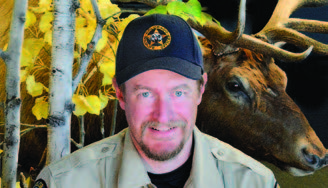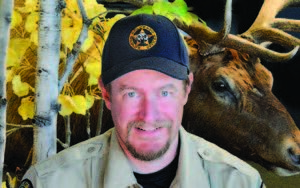
Aaron Berscheid is a district wildlife officer for Colorado Parks and Wildlife. Aaron covers the “wild” side of Northeast El Paso County, including Black Forest, Falcon, Peyton and Calhan. He also covers some of Elbert County, north of U.S. Highway 24 and south of State Highway 86, including the towns of Elbert, Kiowa, Ramah, Simla, Matheson and a small portion of the Limon area.
Holiday decorations: hazardous to wildlife
By Aaron Berscheid, District Wildlife Manager, CPW
Driving through town during the holidays is always a joyful time. Colorful, twinkling lights adorn houses and trees. Garland and ribbons hang on porch railings. Inflatable Santas and reindeer are tethered in front yards.
And while the lights are great for lifting human spirits, they are a downer for our wildlife neighbors.
They represent a potentially serious hazard to animals.
To us, it may seem like nothing more than an unsightly annoyance for a mule deer buck to be sporting new headgear of bright red and green lights.
To the deer, it could represent a serious threat that prevents the animal from being able to eat, drink or move about the landscape. And when a deer’s vision is obstructed, the impact could be on humans because it makes deer more vulnerable to vehicle collisions. The impairment makes the deer more vulnerable to predators, as well.
It’s not just a holiday season phenomenon. Deer get stuck in human contraptions year-round, including tomato cages, hammocks, soccer nets and fences, just to name a few.
But CPW certainly notices an uptick in entanglement related calls during this time of year. It’s an unfortunate coincidence that we start decorating for holidays at the same time bucks are starting the rut — or mating season.
During this time, bucks rub their antlers against trees and bushes to get ready to fight other bucks. When a buck rubs his antlers on a decorated bush, strings of holiday lights get stuck on their antlers.
The result? The buck runs off with your Christmas decorations leaving you wondering if the neighborhood juvenile delinquent struck again.
Sometimes, the string of lights is just on the antlers. If this is the case, we will leave the buck alone and let him show off his holiday spirit. Bucks will drop their antlers over the next couple of months and the string of lights will be shed at the same time.
If a buck has a long string of lights trailing behind, but it is still mobile, we will let it be. We will not tranquilize animals that are still very mobile. It is very stressful and sometimes deadly for an animal to be tranquilized. So we only intervene if we absolutely have to.
When do we intervene? A perfect example was last year when a buck in the Colorado Springs Broadmoor neighborhood had Christmas lights wrapped around his muzzle and even inside its mouth, preventing it from eating normally. This was a life-threatening issue.
We will also come to untangle a deer if it is unable to move freely. For example, if the entangled lights are still attached to a post, preventing the buck from moving locations.
If you see a deer wrapped in decorations, please give us a call. It may be tempting to try to help the buck yourself, but they are wild animals and are dangerous, especially during the rut, and stressed out by unwanted decor.
You can help us out by taking a picture of the deer from a safe distance. We are often able to tell if we need to intervene from the pictures you send us.
Here are some other tips you can follow to prevent wildlife from getting tangled in your holiday decorations:
- Wrap decorations as tightly as possible around posts and trees.
- If you wrap lights around trees, place them higher than 6 feet off the ground and tightly secure the ends.
- Do not drape lights over bushes or trees.
- Tightly secure any decorations that are attached to a house or building.
- When not in use, bring inside hammocks, soccer/volleyball nets, swings, tomato cages and other items deer commonly get stuck in.
In the coming months, I’ll share more stories as I write about wildlife issues in our community. If you have a question, problem or column idea, please email me at aaron.berscheid@state.co.us or call me at 719-227-5231.
I might even answer your question in a future installment of “Wildlife Matters.”




